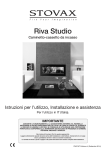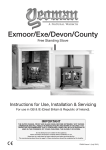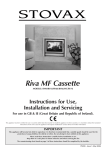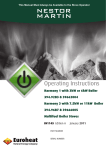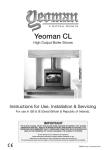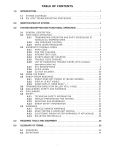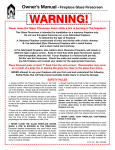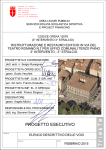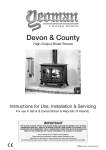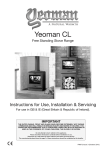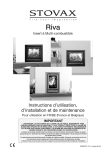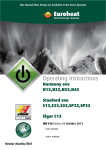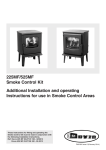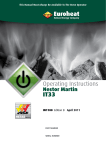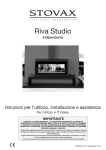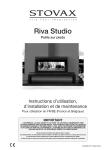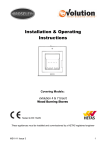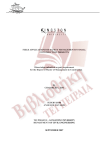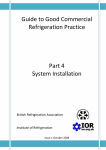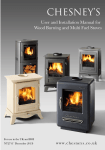Download Studio Installation & User Instructions
Transcript
Riva Studio Inset Convector Cassette Instructions for Use, Installation & Servicing For use in GB & IE (Great Britain & Republic of Ireland). This edition incorporates PM400 Issue 4 for the purposes of installation in Smoke Control Areas. IMPORTANT THE OUTER CASING, FRONT AND GLASS PANEL BECOME EXTREMELY HOT DURING OPERATION AND WILL RESULT IN SERIOUS INJURY AND BURNS IF TOUCHED. IT IS THEREFORE RECOMMENDED THAT A FIREGUARD COMPLYING WITH BS 8423:2002 IS USED IN THE PRESENCE OF YOUNG CHILDREN, THE ELDERLY OR INFIRM. Do not attempt to burn rubbish in this appliance. Please read these Instructions carefully before installation or use. Keep them in a safe place for future reference and when servicing the fire. The commissioning sheet found on page 3 of these instructions should be completed by the Installer. PM274 Issue 14 (March 2015) Contents Riva Studio Cassette - Inset Convector Covering the following models: RVST-500/RVST-1HT/RVST-2HT/RVST-3HT Appliance Commissioning Checklist.......................3 User Instructions........................................................4 Getting Started............................................................................ 4 User Instructions......................................................................... 6 Care & Maintenance................................................................... 9 Troubleshooting.......................................................12 Installation Instructions...........................................14 Installation Checklist.................................................................. 14 Pre-Installation Instructions....................................................... 18 Installing the Appliance............................................................. 21 Commissioning.......................................................................... 33 Maintenance & Servicing.........................................35 To receive your Extended Warranty your Stovax appliance must have been purchased from our Expert Retailer Network and registered within one month of purchase or installation. Please note that all warranties are effective from the date of purchase. Any Stovax product purchased outside of our Extended Retailer Network, or not registered within the stated time will carry a standard 12 month warranty. It is a condition of the Extended Warranty that the installation complies with the relevant Building Regulations and is carried out by a suitably trained and qualified individual (HETAS in the UK or equivalent in other countries) with the certificate of installation and the Commissioning Report on Page 3 completed and retained by the end user. Full terms and conditions are detailed in the Warranty Statement on the Stovax website www.stovax.com. In the event of any conflict of information the wording on the website shall prevail. Important Note: Should any problems be experienced with your product, claims must first be submitted to the Expert Retailer where the appliance was purchased from who will offer immediate assistance or contact Stovax on your behalf. Technical Appendix..................................................39 Spare Parts List......................................................................... 43 Service Records........................................................................ 47 2 DESIGN PROTECTION The Studio design, including it's frames and accessories, are protected by European Design Registration No. 001169338 0002 0008. Appliance Commissioning Checklist To assist us in any guarantee claim please complete the following information:Dealer appliance was purchased from: Name: Address: Telephone number: Essential information - MUST be completed: Date Installed: Model Description: Serial Number: Installation Engineer: Company Name: Address: Telephone number: Commissioning Checks - to be completed and signed: Is flue system correct for the appliance: YES NO Flue swept and soundness test complete: YES NO Smoke test completed on installed appliance YES NO Spillage test completed YES NO Use of appliance and operation of controls explained YES NO Clearance to combustible materials checked YES NO Instruction book handed to customer YES NO CO Alarm Fitted YES NO Signature: ............................................................................ Print Name: .......................................................................... 3 Getting Started Welcome Congratulations on purchasing your Stovax Riva Studio, if installed correctly Stovax hope it will give you many years of warmth and pleasure for which it was designed. The purpose of this manual is to familiarise you with your stove, and give guidelines for its installation, operation and maintenance. If, after reading, you need further information, please do not hesitate to contact your Stovax retailer. 1. General Points 1.1 Before installation and/or use of this appliance please read these instructions fully and carefully to ensure that you have fully understood their requirements. The appliance must be fitted by a registered installer*, or approved by your local building control officer. 1.2 Only use for domestic heating in accordance with these operating instructions. 1.4 You must burn only approved fuels. Do not use with liquid fuels or as an incinerator. 1.5 Appliance surfaces become very hot when in use. Use a suitable fireguard‡ if young children, elderly or infirm persons are present. Stovax offer firescreens, sparkguards and hearthgate systems for protection. Your Stovax dealer can advise you about these products. 1.6 Do not place photographs, TV’s, paintings, porcelain or other combustible items on the wall or near the appliance. Exposure to hot temperatures will cause damage. Do not place furniture or other items such as drying clothing closer than 1m from the front of this appliance. WARNING: Extra fuel should not be stored on or next to the appliance. Only keep enough fuel for immediate use nearby and never leave the appliance unattended for long periods with any combustible material in close proximity. 1.7 Extractor fans or cooker hoods must not be placed in the same room or space as this can cause appliance to emit fumes into the room. 1.8 Do not obstruct inside or outside ventilation required for the safe use of this appliance. ‡In the U.K. these products must conform to the latest edition of BS 8423, Fireguards for use with solid fuel appliances. If appliance is operating unattended they must conform to the latest edition of BS 3248 *Registered on the Competent Persons Scheme (GB only see page 42/ INFO (Republic of Ireland). 4 Do not make unauthorised changes to the appliance. 1.10 The chimney must be swept at least once a year. See Section 12. 1.11 Do not connect, or share, the same flue or chimney system with another appliance. SERIAL NUMBER 1.12 This number is required when ordering spare parts or making warranty claims. It is found on the appliance data plate, see Diagram 1. 1 All local regulations, including those referring to national and European Standards need to be complied with when installing the appliance. 1.3 1.9 Data Plate Studio 3 Data plate only accessible when door is closed Triple Air Systems Several Stovax appliances have triple air systems providing cleaner burning, and greater efficiency and control, See Diagram 2 1) Airwash - air drawn over the window cleans the glass. The source of Primary Combustion air when burning wood. 2) Primary Air - for use initially when establishing fires. 3) Secondary Air - Secondary air is preheated through a heat exchanger to combust unburned hydrocarbons, providing a cleaner and more efficient burn. 1 2 3 2 Getting Started Airwash and Primary Air Controls Studio 500 1,2,3 DOOR HANDLE DO NOT OPEN THE DOOR WITH BARE HANDS 1.13 Use a protective gloved hand to operate. DO NOT OPERATE THE AIR CONTROLS WITH BARE HANDS DO NOT OPEN THE DOORS WHEN THE FIREBOX IS FULL OF FLAMES - WAIT FOR THEM TO DIE DOWN. Studio 500, 1 & 2 Airwash Control 3 1.14 Use a protective gloved hand to operate. Slide tool over knob to fit. 1.15 Move the slider to the left to open, see Diagram 4. Secondary Air Inlet Factory Set 4 OPEN Primary Control NOTE: The travel of the Airwash control and Primary control may be limited if the appliance has been set up to operate in a Smoke Control Area. CLOSED Studio 3 1.16 Engage tool in door as shown, see Diagram 5. Pull door out and down to open. 5 Operating tool 5 User Instructions WARNING Properly installed, operated and maintained this appliance will not emit fumes into the room but occasional fumes from de-ashing and refuelling may occur. Persistent fume emission is potentially dangerous and must not be tolerated. If fume emission persists: • Open doors and windows to ventilate the room. • Leave the room. • Allow fire to burn out or safely dispose of fuel from the appliance. • Check for chimney blockage and clean if required. • Do not attempt to relight until the cause of the emission has been identified and corrected. • If necessary seek expert advice. • All open flued appliances can be affected by temporary atmospheric conditions which may allow fumes to enter the house. Because of this an electronic carbon monoxide detector conforming to the latest edition of BSEN50292 must be fitted in the same room as the appliance. The existence of an alarm must not be considered a substitute for ensuring regular servicing and maintenance of the appliance and chimney system. 3. Recommended Fuels 3.1 Wood Logs: Burn only seasoned timber with a moisture content of less than 20%. To ensure this allow cut wood to dry for 12 to 18 months. Appliance 2.3 During this time the appliance may give off some unpleasant odours. Keep the room well ventilated to avoid a build-up of fumes. 2.4 Please be aware that, during use, rope seals may discolour. This is normal. 6 250mm - 300mm Riva Studio 2 250mm - 400mm Riva Studio 3 250mm - 500mm Poor quality timber: — Causes low combustion efficiency — Produces harmful condensation — Reduces effectiveness of the airwash and life of the appliance Do not burn construction timber, painted, impregnated / treated wood, manufactured board products or pallet wood. 3.2 Fuel consumption. As tested at nominal heat output to the requirements of EN 13229: 2001 for intermittent operation: Fuel Consumption Description To allow the appliance to settle, and fixing glues and paint to fully cure, operate the appliance at a low temperature for first few days. Do not touch the paint during the first period of use. 250mm Riva Studio 1 2. Using the Appliance for the First Time 2.2 Wood Length Riva Studio 500 IF THE ALARM SOUNDS FOLLOW THE INSTRUCTIONS GIVEN ABOVE. 2.1 Wood Length 6 Kg/hour Wood Riva Studio 500 1.4 Riva Studio 1 1.6 Riva Studio 2 2.4 Riva Studio 3 3.6 A number of factors can affect the performance of the appliance. See Troubleshooting Section for details. Fuel Overloading The maximum amount of fuel specified in this manual should not be exceeded, overloading can cause excess smoke. User Instructions 4. Smoke Control Kit This section applies to the Riva Studio products listed: 4.1 Product Code Appliance RVST-500 Riva Studio Cassette 500 RVST-1HT Riva Studio Cassette 1 RVST-2HT Riva Studio Cassette 2 The Studio models listed are supplied with a pre-fitted smoke control kit and have been independently tested to PD6434 making them exempt from the controls that generally apply in Smoke Control Areas. 4.2 These models are suitable for use in a Smoke Control Area when burning wood and following the instructions for use specified in this manual but ONLY if the Smoke Kit has not been removed. 4.3 If fitted, the Smoke Control kit can be seen in the following locations, see Diagrams 7 & 8. 7 If these Studio models are installed outside of a Smoke Control Area then the Smoke Control kit can be removed to give more control over the lower burn rates. Removing the kit should only be done by a suitably qualified installer and must be done at the time of installation. These instructions must be left with the User. 5. Lighting the Appliance 5.1 9 For best results set air controls as shown, see Diagram 9. Air Wash: Fully Open Airwash Primary Air: Fully Open Frame Airwash Restrictor Gap between Inner and Outer box Glass 8 Primary Air Door 5.2 Place firelighters or paper and dry kindling wood on the base bricks. A successful fire initially requires plenty of kindling to establish a hot firebox and warm the chimney to aid flue performance. 5.3 Light the paper or firelighters, see Diagram 10. 5.4 Leave the door slightly open as the fire establishes and the glass warms to avoid build up of condensation. 10 Primary Air Restrictor Gap between Inner and Outer box 4.4 To meet the requirements of a Smoke Control Area the appliance MUST be operated correctly in order to minimise the amount of smoke produced. 5.5 Add larger pieces of wood. Do not use full sized logs at this stage, build up gradually in size. Too many logs may smother the fire. 7 User Instructions Fuel Loading: These are wide appliances and the logs should be laid out in a single layer with gaps between, see Diagram 11. Do not stack the logs on top of each other as this could effect the efficiency. DO NOT OVERLOAD THE APPLIANCE AS THE HEAT OUTPUT WILL BE TOO HIGH. Be sure to use split logs and not whole pieces of wood. Too much fuel in the firebox will cause the appliance to reach higher temperatures than intended. This can damage the interior components of the fire. Suggested Loads: Studio 500 - 2/3 logs no bigger than 5" (127mm) diameter Studio 1 & 2 - 3/4 logs no bigger than 5" (127mm) diameter Studio 3 - 4/5 logs no bigger than 5" (127mm) diameter 6. Running the Appliance Burning Wood 6.1 Close the Primary air control and use the Airwash to control the burn rate when appliance is at operating temperature, see Diagram 12. Air Wash: Adjust Burn Rate 12 Min Max 11 Primary Air: Close 5.6 Close the door and follow the instructions for Running the Appliance. Do not run with the door slightly open except for initial lighting as this could cause over-firing and damage the appliance. WARNING: DO NOT OPERATE THE APPLIANCE WITH THE PRIMARY AIR CONTROL OPEN FOR LONG PERIODS OF TIME AS THIS COULD CAUSE OVERFIRING AND MAY CAUSE PERMANENT DAMAGE. Wood burns best on a bed of ash (approx. 25mm (1") deep). 6.2 Do not burn large amounts of fuel with the Airwash Control closed for long periods of time. This reduces the glass cleaning effect of the Airwash and causes tars and creosotes to build-up in the appliance and flue system. 6.3 When in use, burning the appliance at a high temperature for a short period reduces tars and creosotes. WARNING: DO NOT OPERATE THE APPLIANCE WITH THE PRIMARY AIR CONTROL OPEN FOR LONG PERIODS OF TIME AS THIS COULD CAUSE OVERFIRING AND MAY CAUSE PERMANENT DAMAGE. Experience establishes settings to suit personal preference. Refuelling 6.4 Open the Primary Air and Airwash controls fully. Rake the embers evenly over the firebed to establish a glowing firebed. If the firebed is low add a small amount of kindling wood to help re-establish the fire. 6.5 Do not refuel when a large amount of flames are in the firebox as this could cause smoke or flames to spill into the room. 6.6 Close the doors immediately after refuelling. These are wide appliances and the logs should be laid out in a single layer with gaps between, see Diagram 11. Do not stack the logs on top of each other as this could effect the efficiency. DO NOT OVERLOAD THE APPLIANCE AS TOO MUCH FUEL COULD CAUSE IT TO OVER-FIRE. 8 Care & Maintenance 6.7 After refuelling: Burn the new logs at high output for a few minutes before closing the Primary Air control. Adjust the burn rate using the Airwash control. Do not close the air controls until the fire is burning well. 6.8 Do not burn large amounts of fuel with the Airwash control closed for long periods of time. This reduces the glass cleaning effect, causes tars and creosotes to build-up in the appliance and flue system and will produce excessive amounts of smoke. 6.9 When running the appliance refuel little and often for clean, efficient burning. A bright and clean firebox indicates the appliance is burning well. 8. Ash Removal 8.1 Wood burns best on a bed of ash Do not allow ash to build up in the appliance as it will not burn properly and may cause damage. 8.2 Open door, see Diagrams 4&5 on page 5. Remove ash with a small shovel (available from Stovax). Take care not to damage the ceramic lining of the appliance. Do not use sharp pointed pokers. 8.3 8.4 8.5 6.10 Do not burn continuously with the door open. Shut Down 9.2 6.12 Always have enough air entering the stove to maintain some flame within the firebox. 6.13 If it is necessary to shut down the appliance then run on a high setting until all of the fuel has been burnt before closing the air controls. 7. Extended Burning 7.1 It is possible to get the appliance to burn for extended periods of time. In order to do this: — De-ash prior to final refuelling. — Burn new fuel at a high temperature for a few minutes before closing the Primary Air Control. Carefully place the ash into a Stovax Ash Caddy (Stovax Part No. 4227). Do not place hot ash in a container made from plastic or any other combustible material. 9. Over-Firing 9.1 6.11 If there is still burning fuel in the firebox, Stovax do not recommend shutting down the air controls completely unless there is a chimney fire in progress (see Section 9 for advice). Closing the controls during the burning process will cause poor combustion and could lead to a build up of gasses that could ignite dangerously. Remove ash carefully - heat can remain long after use. Do not over-fill with fuel or run at high temperatures for long periods or over-firing can occur. DO NOT OPERATE THE APPLIANCE WITH THE PRIMARY AIR CONTROL OPEN FOR LONG PERIODS OF TIME AS THIS COULD CAUSE OVER-FIRING AND MAY CAUSE PERMANENT DAMAGE. Over-firing can cause permanent damage to the appliance and invalid the product warranty. 10. Chimney Fire 10.1 If a chimney fire occurs: — Shut all air controls immediately. — Evacuate the building. — Call the fire brigade. — Do not re-enter the building until it is confirmed safe. 10.2 Do not use the appliance after a chimney fire until: a) It has been inspected by a registered installer*, confirming the appliance is safe to use. — Set Airwash to low combustion settings. This will gradually blacken the glass but it will clear when operated at a high temperature for a short period. b) The chimney system has been inspected and swept by a chimney sweep, confirming the system is structurally sound and free from obstruction*. c) It is repaired as required before re-use. Use only genuine Stovax replacement parts to keep your appliance in safe, efficient working order. NOTE: An appliance without a Smoke Control kit fitted will burn longer than an appliance the complies to the restrictions of a Smoke Control Area, see Section 4. *Registered on the Competent Persons Scheme (GB only) see page 42/ INFO (Republic of Ireland). 9 Care & Maintenance 11. General Cleaning 11.1 Clean and inspect the appliance regularly, especially in periods of heavy use. Regular cleaning and maintenance will help give many years of safe use. 11.2 Allow appliance to cool thoroughly to avoid risk of burns. 11.3 Clean regularly, according to level of use. 11.4 Remove the ash completely (see User Instructions, Section 8). 11.5 Check internal components for damage - grates, bricks, baffles - and for obvious build up of soot, ash or debris above the flue baffle(s) (these can be found in the upper part of the firebox). Use a torch if necessary. 11.6 If there are any signs of a build up of debris above the flue baffle(s) either: — Arrange for the chimney to be swept (see User Instructions, Section 13). — Remove the baffles and clear the debris (see Pre-Installation Sections). 11.7 To refresh painted finishes a touch up spray is available. Contact your Stovax retailer quoting the serial number found on the appliance data badge. Do not use aerosol sprays near an operating appliance. 12. Cleaning Glass 12.1 Keep the glass clean with correct use of the Airwash system and good quality fuel. 12.2 Sometimes additional cleaning may be required. Before undertaking this operation allow appliance to cool fully. Do not clean hot glass. 12.3 On appliances with printed glass do not use cleaning agents that have a high alkaline or acidic content, for example Stovax Gel Cleaner, these are aggressive cleaning agents designed to be used with heavily stained clear glass. On printed glass surfaces, use Stovax Glass Cleaner (Stovax No.4103) which is better formulated for this application. 12.7 Some types of wood can cause a white residue to form on the glass. If this occurs it should be cleaned off at least once a week during periods of heavy usage. If the liquid cleaning agents recommended do not remove this residue Stovax offer a dry cleaning pad which will help remove heavy stains. 12.8 Before relighting the appliance ensure the glass is fully dried. If the rope seal has absorbed excess cleaning agent it is advisable to replace the rope as soon as possible to preserve the printed finish of the glass. 13. Chimney Sweeping 13.1 To maintain safe and efficient use of the appliance, the chimney/flue must be inspected and swept at least once a year by a qualified chimney sweep*. If the appliance is used continuously throughout the year, or it is used to burn wood, more frequent sweeping is recommended. The best time to have the chimney swept is at the start of the heating season. 13.2 The chimney, any connecting flue pipe and the appliance flue ways, if incorporated, must be regularly cleaned. 13.3 Ensure adequate access for cleaning where it is not possible to sweep through the chimney. 13.4 If the chimney is believed to have previously served an open fire it must be swept a second time within a month of regular use after installation. 14. Care Of Stove Stovax has a range of cleaning and maintenance products and accessories to keep your appliance in good working order. Your Stovax retailer can advise you on suitable items for your stove and provide genuine spare parts such as replacement glass, door sealing rope and firebricks. View the extensive range at www.stovax.com by clicking on Accessories. In addition, an annual service by a competent engineer is recommended to keep your stove in the best possible condition. 12.4 Before applying a cleaning agent remove any dust and loose soot with a damp cloth. 12.5 Use an appropriate glass cleaner. Apply the cleaning fluid to a cloth before rubbing onto the glass. Apply carefully and do not apply excessively. Try to prevent any run off which could soak into the rope seals around the edge of the glass. Soot can also contain acidic particles that can cause corrosive damage to printed glass. 12.6 Remove dirt with a moist cloth and buff dry. *Registered on the Competent Persons Scheme (GB only) see page 42/ INFO (Republic of Ireland). 10 Care & Maintenance 15. Seasonal Use 15.1 Clean and service the appliance if not used during the warmer months, as detailed in the Maintenance and Servicing section. 15.2 Set the air controls to 50% to keep the appliance ventilated and stop the build-up of any moisture inside. 15.3 Before re-lighting the appliance: —Remove the baffles. —Clear any debris that may have accumulated. —Check the flue is clear of any blockages. 16. Optional Extras Fan Kit 16.1 This appliance can be fitted with an optional convection fan kit. The fan must be fitted at the time of installation. For installation and operating procedures you must refer to the instructions supplied with the fan kit. Outside Air Kit 16.2 This appliance can be fitted with an optional kit to help bring air directly into the appliance from outside. The For installation and operating procedures you must refer to the instructions supplied with the Outside Air kit. Warm Air Ducting Kit 16.3 This appliance can be fitted with an optional Warm Air Ducting kit to help circulate warm air to other room in the house. This operation may require additional ventilation in order to comply with building regulations and a qualified installer should be consulted before fitting. The Ducting kit must be fitted at the time of installation. For installation and operating procedures you must refer to the instructions supplied with the Warm Air Ducting kit. 11 Troubleshooting Troubleshooting Symptom Cause Solution Low flue draught Consult your installer Wet wood (over 20% moisture) Use dry seasoned wood (less than 20% moisture content) Poor burning control High flue draught Consult your installer Short burn times Wet wood (over 20% moisture) Insufficient amount of fuel Refer to the table in section 3 Use dry seasoned wood (less than 20% moisture content) High flue draught Consult your installer Air control left fully open Close air control to reduce output Low flue draught Consult your installer for advice on suitable flue system Wet wood (over 20% moisture) Use dry seasoned wood (less than 20% moisture content) High flue draught Consult your installer for advice on suitable flue system Over dry wood Do not use constructional timber or pallet wood Wet wood (over 20% moisture) Use dry seasoned wood (less than 20% moisture content) Low flue draught Consult your installer for advice on suitable flue system Incorrect additional ventilation air in to building Consult your installer Continuous smoke spillage into room when appliance in use Blocked flue Open all doors and windows to ventilate the room. Allow the fire to burn out. Check flue for blockage. Do not re-use until cause of spillage is identified. Consult your installer for advice Blue/grey smoke from chimney Wet wood (over 20% moisture) Use dry seasoned wood (less than 20% moisture content) Windy days, intermittent smoke spillage into room when appliance door is opened Down draught in flue caused by air turbulence caused by nearby buildings or trees Weather conditions combined with the flue terminal position can have an effect on the appliance performance. Consult your installer Calm days, intermittent smoke spillage into room when appliance door is opened Over size flue giving poor flue draught Weather conditions combined with the flue terminal position can have an effect on the appliance performance. Consult your installer Damp/Rainy days lighting and burning problems Flue temperature low / rain water inside flue Use good quality wood to start and maintain the fire, consult your installer to fit a rain cowl Wind noise from the air control High flue draught Consult your installer for advice on suitable flue system OPERATION Difficulty starting the fire and keeping it burning well Excessive heat output (Over firing) Low heat output Excessive fuel consumption ADVERSE WEATHER SMOKE EMISSIONS Smoke and small flames 12 Intermittent smoke spillage into room when appliance door is opened Troubleshooting Symptom Cause Solution Wet wood (over 20% moisture) Use dry seasoned wood (less than 20% moisture content). Operate at a high temperature for short periods each time the appliance is used to avoid large build-ups of tars and creosotes Appliance operated at continuous low temperatures Operate at a high temperature for short periods each time the appliance is used to avoid large build-ups of tars and creosotes. See user instructions for correct use of air control Using poor quality wood Use dry seasoned wood (less than 20% moisture content) Appliance operated at continuous low output Operate at high output for short periods. See user instructions for correct use of air control Using poor quality wood Use dry seasoned wood (less than 20% moisture content) Wind noise from the air control High flue draught Consult your installer for advice on suitable flue system Dirty firebricks Wet wood (over 20% moisture) Use dry seasoned wood (less than 20% moisture content) Dirty glass Wet wood (over 20% moisture) Use dry seasoned wood (less than 20% moisture content) Using poor quality wood Use dry seasoned wood (less than 20% moisture content) Low flue draught Consult your installer for advice on suitable flue system Incorrect use of air control See user instructions for correct use of air control Appliance operated at continuous low temperatures Operate at high output for short periods. See user instructions for correct use of air control Rapid creosote build-up in the chimney THE APPLIANCE Tar coming from flue joints Strong pungent smell after the appliance is lit Glass blackening The flue system has two main functions: FLUES - To safely remove the smoke, fumes and combustion gases from the building. - To provide a sufficient amount of flue draught (suction) in the appliance to ensure the fire keeps burning. The flue draught is caused by rising hot gases when the appliance is lit. Tar and creosote are a major cause of chimney fires. If the appliance experiences problems with tar build up consult a chimney sweep before continued use of the appliance. For advise on the correction of persistent flue problems consult a qualified heating engineer before continuing to use the appliance. 13 Installation Checklist Please Note This section is intended to give an overview of the product performance and essential information required for installing the appliance. It is intended for qualified engineers who are already familiar with Stovax products. For full details and expanded information please see the Technical Appendix at the back of this manual. 1. Riva Studio Dimensions 1 H Diameter (Ø) A NOTE: Studio 3 models have 4 vents across the top F G K E B C D L N M 20mm P Description Model A B C D E F G H K L M N P Riva Studio 500 RVST500 552 415 350 628 497 246 380 153 (6") 240 96 350 276 155 Riva Studio 1 RVST-1HT 745 415 350 821 497 246 480 153 (6") 240 96 592 372.5 155 Riva Studio 2 RVST-2HT 950 440 350 1019 522 246 610 153 (6") 240 105 735 475 150 Riva Studio 3 RVST-3HT 1332 450 393 1406 532 291 153 (6") 275 105 735 766 150 All dimensions in mm. (25.4 mm = 1”) 14 610 1010* Installation Checklist 500 1 2 3 Riva Studio 3 Studio Studio Studio Studio Riva Studio 2 Riva Riva Riva Riva Riva Studio 1 GENERAL Model: Riva Studio 500 2. Essential Information 4.9 5.0 8.0 11.0 Nominal Heat Output Wood kW Efficiency Wood % 80.0 74.6 75.3 75.6 CO @ 13% O2 Wood % 0.290 0.230 0.180 0.247 Kg 85 76 83 120 Weight Recommended Fuels Wood Seasoned Wood (less than 20% moisture content) As tested to the requirements of EN 13229 for intermittent operation With Liner of Factory made system (diameter) Flue/Chimney Size installed in accordance with manufacturers instructions Flue/Chimney All products FLUES minimum height mm 153 153 153 153 inch 6 6 6 6 m 4.5 4.5 4.5 4.5 feet 15 15 15 15 1.0 1.0 1.0 1.0 1.5 1.5 1.5 1.5 2.0 2.0 2.0 2.0 Min Flue Draught Nominal mm Wg Max Flue Gas Mass Flow Wood g/s 3.9 5.5 6.6 8.6 Flue Gas Temperature at Spigot/Socket Wood oC 265 301 346 352 mm 153 153 153 153 inch 6 6 6 6 Flue Outlet Size (Top Option) VENTILATION European Min Spec for Chimney Flue - T400 N2 D 3 G50 A) Traditionally Built Homes • Where leakage is greater than 5m3/hour/m2. • Ventilation normally required = 550mm2 per kW output over 5kW A B Additional Ventilation Additional Ventilation B) Modern Construction Homes • Where leakage is less than 5m3/hour/m2. • Ventilation normally required = 550mm2 per kW mm2 None None 1650 3300 cm2 None None 16.5 33 in2 None None 2.6 5.3 mm2 2695 2750 4400 6050 cm2 26.9 27.5 44 60.5 in2 4.35 4.44 7.1 9.76 For full technical details on ventilation see Technical Appendix on Page 41 ‡In the U.K. Additional information covering the installation of the appliance may be found in the following British Standards: BS EN 15287, BS6999, BS8303. 15 Installation Checklist 3. Minimum Dimensions - Hearth 5. Clearances to combustibles 2 Superimposed Hearth (or area to be free of combustible material) 150 150 When fitting the appliance use the minimum clearances between any point of the appliance and any combustible material. 4 100 Constructional Hearth 100 100 A 225 500 900 Dimension A Riva Studio 500 860 Riva Studio 1 1050 Riva Studio 2 1250 Riva Studio 3 1650 600 4. Minimum Builders Opening No Combustible Material in this area To make installation easier make the opening slightly larger than the minimum requirements where possible. 3 100 6. Smoke Control Kit Supporting lintel Fill Mid lintel C B A F E 16 E D 250mm minimum to Hearth Dimension A B C D E F Studio 500 575 435 360 425 75 100 Studio 1 765 435 360 615 75 100 Studio 2 970 460 360 820 75 100 Studio 3 1352 475 465 1202 75 100 Void This section applies to the Riva Studio products listed: Product Code Appliance RVST-500 Riva Studio Cassette 500 RVST-1HT Riva Studio Cassette 1 RVST-2HT Riva Studio Cassette 2 6.1 The Studio models listed are supplied with a pre-fitted smoke control kit and have been independently tested to PD6434 making them exempt from the controls that generally apply in Smoke Control Areas. 6.2 These models are suitable for use in a Smoke Control Area when burning wood and following the instructions for use specified in this manual but ONLY if the Smoke Kit has not been removed. Pre-Installation Instructions 6.3 If fitted, the Smoke Control kit can be seen in the following locations, see Diagrams 5 & 6. Airwash 5 7. Optional Extras The Studio has a number of optional extras to enhance the performance of the appliance. These need to be considered when planning the installation. Frame Fan Kit Airwash Restrictor 7.1 Gap between Inner and Outer box This appliance can be fitted with an optional convection fan kit. The fan must be fitted at the time of installation. For installation and operating procedures you must refer to the instructions supplied with the fan kit. Warm Air Ducting Kit Glass 7.2 6 Primary Air This appliance can be fitted with an optional Warm Air Ducting kit to help circulate warm air to other room in the house. This operation may require additional ventilation in order to comply with building regulations and a qualified installer should be consulted before fitting. The Ducting kit must be fitted at the time of installation. For installation and operating procedures you must refer to the instructions supplied with the Warm Air Ducting kit. Outside Air Kit Door Primary Air Restrictor Gap between Inner and Outer box 6.4 7.3 This appliance can be fitted with an optional kit to help bring air directly into the appliance from outside. The For installation and operating procedures you must refer to the instructions supplied with the Outside Air kit. To meet the requirements of a Smoke Control Area the appliance MUST be operated correctly in order to minimise the amount of smoke produced. If these Studio models are installed outside of a Smoke Control Area then the Smoke Control kit can be removed to give more control over the lower burn rates. Removing the kit should only be done by a suitably qualified installer and must be done at the time of installation. These instructions must be left with the User. 17 Pre-Installation Instructions 1. General 1.1 To make the installation of the appliance easier it is best to remove the internal components before fitting into the builders opening/studwork. 1.2 For the best results removing the following components as set out below. 2.5 Lie the door face down on a soft flat surface to protect the paint work and glass. 2.6 Reverse the procedure to re-fit the door. Studio 3 This will require 2 people. 2.7 Open the door fully (see User Instructions, page 5). 2.8 2. Removal of the Door Studio 500, 1 & 2 3 Before removing the door it is recommended to protect the left edge from damage using masking tape. 2.1 Open the door approximately 90˚, see Diagram 1. 1 ø3mm pin in each hinge Hinge block 90˚ 2.2 Move the Air Control to the far right, see Diagram 2. 2.9 Raise the door vertically at the front. 2.10 Lower the door approximately 5mm and pull away from the appliance. 2.11 Lie the door face down on a soft flat surface to protect the paint work and glass. 2.12 Reverse the procedure to refit the door. 2 3. Removal of Internal Components In the firebox of the Studio are several loose items including: • A box containing: Baffle Bricks Firebricks Bag containing Instruction Manual, Warranty & Door Tool, Log Guard End Supports • Log Guard • Front Baffle Support Air Control handle 3.1 45˚ 2.3 Lift the door vertically to remove from the hinge block, see Diagram 1. 2.4 Close the door 45˚, ensuring the Air Control handle sits inside the channel in the top of the door (see Diagram 2) and carefully manoeuvre the door clear of the hinge mechanism. 18 Lock the hinges in position using a ø3mm pin as shown in Diagram 3. Remove these carefully and put them safely to one side. They can be fitted after the appliance has been installed, see Installation Section. Pre-Installation Instructions 4. Removal of the Top Baffles Studio 3 6 The appliance is fitted with baffles in the top of the firebox to maintain efficient combustion. Studio 500 and Studio 1 have 1 baffle. Studio 2 has 2 baffles. Studio 3 has 3 baffles. 4.1 Once the loose internal components have been removed it is possible to remove the metal Top Baffles. Allow the appliance to cool fully before removing the baffle system. Studio 3 Studio 500 & Studio 1 4 Studio 1 & 500 The Studio 3 baffle comes in three sections. To remove the baffle system the baffles must be taken out in the following order: Left hand side Middle Right Hand side The method of removal is the same for all sections. All Models 4.2 These models have a single section baffle. Studio 2 5 4.3 Studio 2 7 Use two hands and lift the front edge of the baffle to clear the support tabs at the front of the firebox. Push the baffle towards the back of the appliance to free it from the tabs at the front, see Diagram 7. Lower the baffle into the firebox to disengage from the support pins and carefully withdraw through the front of the appliance, see Diagram 7. Take care not to damage the firebricks. Support Pins 3. Lower The Studio 2 baffle comes in two sections. To remove the baffle system first disengage the left hand side. The method of removal is the same for both sections. Tabs 2. Push Back 1. Push Up 4.4 If the appliance has more than one baffle remove in the correct order. 4.5 Replace in reverse order. 4.6 The baffle system is designed to give safe and efficient operation of the stove. Replace damaged baffles immediately. 4.7 Do not modify the baffle system. Do not operate with the baffle system removed. 19 Pre-Installation Instructions 5. Separate the Inner & Outer Box To protect the delicate parts of the appliance the product has been designed so that the inner box can be removed from the outer box. Keep the inner box in a safe place whilst the outer box is installed into the fabric of the house, the main flue connections made and the walls finished. When all the heavy work is complete the inner box can be re-installed into the outer box and the final connection made. 5.1 The internal components, bricks, baffles and the door etc should be removed to make the installation process easier and prevent damage. 5.2 First remove the inner collar, see Diagram 8. 8 5.3 9 Inner Collar 4 Bolts First remove the inner collar. Using a 13 A/F spanner, remove the 4 x bolts, see Diagram 9. Long bolts - front Short bolts - rear Recessed into Inner Collar 5.4 10 20 The inner box can now be slid out of the outer box. There is a roller assembly at the rear which locates in cutouts on the outer box, see Diagram 10. Pull the inner box carefully forward to release from the cutouts. It should now slide smoothly out of the outer box. This will require at least two people. Installation Instructions 2.2 1. Installing the Appliance Removal Of Outer Collar 2 Each installation is unique to the property so it is not possible to give details to suit every setting. The installation must comply with Building Regulations† and be made using "best practice" construction methods‡. Outer Collar The clearance to combustible materials for the Stovax Studio models is greatly different due to the higher temperatures that the appliance can reach. Extra care must be taken when creating a builders opening. Pay careful attention to the distance to combustible materials recommended and ensure the housing for the appliance is built from non-combustible material. Many fireplace openings have a supporting lintel. Do not remove without supporting the remaining structure of the building. Do not support the structure with the appliance or the flue system. Using a 13 A/F Spanner remove the 3 bolts and remove outer collar. There is a Flue Collar Bracket on top of the Outer Box. This locates on two pins that allow flexibility when replacing the Outer Collar. The bracket remain in place when installing the flue system, see Diagram 3. 1.1 Take care when installing the appliance. Careless handling and use of tools can damage the finish and/or area. There are two types of installation for this appliance: Fitting to a Masonry Chimney - Section 2. Studwork Installation - Section 3, 4 & 5. All methods of installation will require the attachment of frame fixing brackets prior to the installation of the outer box see Section 3.6. 3 2. Fitting to A Masonry Chimney 2.1 Many fireplace openings have a supporting lintel. Do not remove without supporting the remaining structure of the building. Do not support the structure with the appliance or the flue system. Stovax recommend the use of a flue liner when installing into a masonry chimney. Alternative methods can be used if the chimney is sound and correctly sized, however access may be required to make an effective seal - ie Using a sump adapter. Important Note: If you plan to install an optional fan kit preparation must be made for the installation of wiring and sockets. 1 250mm minimum if fan kit fitted For opening sizes see Installation Checklist. 2.3 If the optional fan is to be fitted, remove the fan cover in the base of the outer case. This cannot be removed after the outer case has been installed. Full instructions are included with the fan (PM379). Fit frame fixing brackets or Edge/Cool Wall frame as required. See alternative frame instructions (PM378) for individual fixing methods. 2.4 The outer box can be slid into the chimney opening and fitted. Ensure provision for a vent of at least 200 cm2 is made † England and Wales – Document J / Scotland Part F/Document J (Republic of Ireland only) ‡ the latest edition of BS 8303, BS EN 15287, BS 7566 21 Installation Instructions 2.5 The position of the box can now be improved within the builder's opening by adjusting the four levelling feet to ensure it sits firm and level at all four corners, see Diagram 4. 2.7 Flue Assembly The flue liner can now be lowered through the outer box and connected to the outer flue collar using a suitable flexible flue liner adapter. Make sure that these joints are secured using suitable stainless steel fasteners and sealed with fire cement. 4 6 Flue liner (typical) Adjust each corner using leveling feet Wind the set screws down to the desired position in each corner. 2.6 Use M6 or M8 bolts to secure the outer case to the masonry of the fireplace. There must be at least two bolts in the back of the outer case and one in either side. These can be secured through the sides or base of the outer case. Check the security of these fasteners before proceeding to fit the inner box. 100mm (minimum) Ensure flue is clear of masonry 15mm (typical) wall finish Supporting lintel Fill Mid Lintel The side fixings may be positioned by drilling though the firebox into the base of the outer box and fixing within the shaded area shown in Diagram 5. Do not over tighten and deform the firebox. Studio Outer Box This appliance MUST be securely fixed in position to support the door when opened. 5 250mm (minimum) if fan is fitted Shaded area for fixing bolts Flue Liner 120 Adaptor Outer Flue Collar 22 Installation Instructions 2.8 7 Push / pull the flue liner back up into the flue ensuring the outer flue cover clears the screws at the rear of the box. Secure the outer collar to the Flue Collar Bracket using the 3 x bolts, ensuring they are finger tight only, see Diagram 7. 3 x Outer flue collar bolts 2.12 Inserting the Inner box Slide the inner box into the outer box. There is a roller assembly at the rear of the inner box which locates in cutouts in the base of the outer box, see Diagram 9. This will require 2 people, see Diagram 9. 9 Raise collar over screws in rear of box 2.9 8 To ensure the outer collar is central, and to avoid cross threading of the bolts during actual installation, feed the 4 bolts used to secure the inner collar into the holes in the outer collar as shown in Diagram 8. This should be done by hand and the bolts should be finger tight only. Do not force the bolts. If they are not easily located remove them and loosen the 3 x bolts holding the outer collar to allow for adjustment. 4 x Inner flue collar bolts 2.13 Apply fire cement in to the faces shown prior to fitting the inner collar, Diagram 10. 10 Inner Flue Collar Fire Cement 2.10 Once the 4 x bolts have been successfully located in the holes tighten the 3 x bolts securing the outer collar in place to create a good seal. Do not over tighten the bolts. 2.11 Remove the 4 x bolts and put them to one side until needed. 2.14 Fit the inner flue collar using the 4 bolts ensuring the 2 longer bolts are at the front and recessed into the Flue Collar, see Diagram 11. All bolts must be finger tight only at this stage. 11 Long bolts - front Short bolts - rear NOTE: The flue liner must be supported in accordance with the manufacturers instructions, there should be no weight on the Outer Box. NOTE: If this appliance is NOT being fitted in a Smoke Control Area then the two parts that restrict the range of the air control sliders can be detached. Recessed into Inner Collar If the customer wants the ability to shut down the appliance completely, the air control sliders MUST be removed now as they cannot be accessed after installing the inner box. See Section 7 on how to remove the restrictors. DO NOT REMOVE THESE RESTRICTORS IF FITTING THE APPLIANCE IN A SMOKE CONTROL AREA. 23 Installation Instructions 2.15 Ensure that the front of the inner box is parallel to the outer box, see Diagram 12. Adjust the position until correct and then fully tighten the 4 bolts. Do not over tighten. NOTE: When correctly installed the inner box sits proud of the outer box, see Diagram 12. 12 Outer Box Inner Box 3. Studwork Installation 3.1 DISTANCE TO COMBUSTIBLE MATERIAL ALL PARTS OF THE STUDWORK MUST BE NON COMBUSTIBLE - FOR EXAMPLE METAL STUDDING. DO NOT USE COMBUSTIBLE MATERIAL WITHIN THE DIMENSIONS BELOW. USE AN APPROVED TWIN WALL INSULATED CHIMNEY SYSTEM WHEN INSTALLING WITHIN STUDWORK. 14 Ensure both boxes are parallel before tightening collar fixing bolts 100 100 100 Replace the internal components (baffles, bricks, door etc), see relevant Pre-Installation sections. Vent Alternative Flue Outlet Collar 900 600 This appliance can be fitted with an angled outer flue collar. This will give extra clearance by locating the flue liner towards the back of the box. It is available as an optional extra and should be fitted before installation instead of the straight outer collar. 13 No Combustible Material in this area 100 24 Void Vent 3.2 Do not pack the void around or above the appliance with insulation materials such as mineral wool or vermiculite. 3.3 The void built for the cassette must be ventilated to prevent a build up of heat. If the void is sealed then you must fit vents at both low and high levels of approximately 50cm2 each. These vents must take cold air from the room and return warm air back into the room, see Diagram 19. 3.4 An access hatch must be left in the side of the chimney breast for future servicing and inspection of the flue and appliance. Installation Instructions 3.5 Support the outer box using metal framework (ie Unistrut) construction secured to the non combustible floor/wall, Diagram 15. See Diagram 4 for the drilling position in the outer box. 3.7 Build a chimney breast around the outer box using 100mm wide light weight insulating blocks*, Diagram 18. 18 15 Non Combustible Structure Use Non Combustible structure to support across the bottom 3.6 Attach the Studio frame fixing brackets to the fire, see Diagram 16 & 17. See the frame fitting instruction for the individual fixing methods. (Not required if Edge or Cool Wall frames are fitted) 16 Top Bracket Ensure the clearances to combustibles are maintained, see Diagram 14. Fit non-combustible board to the brickwork around the outer box behind the flange to a height of at least 600mm above the opening. Apply a heat resistant plaster finish to at least 900mm above and to the sides of the chimney breast Note: If a slip is used, this needs to be positioned behind the flange. Never use a one-piece slip as expansion (even cracking) can occur. To finish this installation, connect: - the flue system (see Installation, 2.7 Flue Assembly) - and electrical services (for fan installation - optional) using the opening in the side of the chimney breast for access. - The Outside Air Kit (optional) - Convection Ducting Kit (optional) 17 Bottom Bracket After commissioning: Finish the sides of the chimney breast and re-install the inner box, see Diagram 19. 19 50cm2 vents Inspection Hatch * Typical Product - Thermolite R (Hanson UK) 25 Installation Instructions 4. Frameless Edge Installation Kit There is an optional Studio Edge Installation Kit designed to create a minimalist frameless finish making the appliance a focal point of any room: Studio 500 Code No. RVS-500FEK, Studio 1 Code No. RVS-1FEK, Studio 2 Code No. RVS-2FEK, Studio 3 Code No. RVS-3FEK. 4.3 Fit non combustible board to studwork/frame/masonry and leave enough room for the final skim of heat resistant plaster. The depth of the Edge flange will vary depending on the model of Studio. To ensure a flush finish the noncombustible board and the final plaster skim must add up to Dimension A, see Diagram 23 and the table below. 23 A Metal Studding A Brick work The Edge installation kit is provided unfinished. This allows the kit to be finished to match the front face decor. 4.1 To fit the frame: Position on appliance and secure as detailed in the frame fitting instruction. Edge frame Edge frame 20 Stud chimney Brick chimney 21 22 Build the studwork chimney breast to support the cassette, See Diagram 22. Ensure all clearances to combustible material are maintained, See Pre-Installation Section. To prevent cracking ensure no joints above the appliance. A (mm) Studio 500 34 Studio 1 & 2 34 Studio 3 44.5 Standard plasterboard is not suitable This should extend a minimum of 600mm to the sides and above the appliance. Apply a heat resistant plaster finish to at least 900mm above and 400mm to the sides of the chimney breast, making sure it is not too thin or it will crack, see Diagram 24. 24 4.2 Model Non combustible plasterboard Metal Studding Flange Heat resistant plaster NOTE: If this appliance is NOT being fitted in a Smoke Control Area then the two parts that restrict the range of the air control sliders can be detached. If the customer wants the ability to shut down the appliance completely, the air control sliders MUST be removed now as they cannot be accessed after installing the inner box. See Section 7 on how to remove the restrictors. DO NOT REMOVE THESE RESTRICTORS IF FITTING THE APPLIANCE IN A SMOKE CONTROL AREA. 26 Installation Instructions 4.4 Allow for the connection of the following: - Electrical services (for fan installation) using the opening in the side of the chimney breast for access. - The Outside Air Kit (optional) - Convection Ducting Kit (optional) - The flue system (see Installation, 2.7 Flue Assembly) To finish this installation re-install the inner box. 4.5 After commissioning, finish the sides of the chimney breast, see Diagram 25. 27 25 50cm2 vents 5.2 The frame determines the width of the two vertical studwork supports. The kit has been designed so that noncombustible board can be taken right up to the edge of the frame, see Diagram 28. 28 Inspection Hatch 5. 'Cool Wall' Installation Kit The Cool Wall kit gives the appliance a stylish frameless Edge finish but allows the convected heat of the fire to be channelled into the chimney cavity and vented at the top: Studio 500 Code No. RVS-500FCWK, Studio 1 Code No. RVS-1FCWK, Studio 2 Code No. RVS-2FCWK, Studio 3 Code No. RVS-3FCWK. 5.3 The Cool Wall installation kit is provided unfinished. This allows the kit to be finished to match the front face decor. 5.1 To fit the frame: Position on appliance and secure as detailed in the frame fitting instructions. There is a gap at the top for convected heat to pass behind the finished wall. When constructing the studwork chimney breast the depth of the Cool Wall flange will vary depending on the model of Studio. To ensure a flush finish the non-combustible board and the final plaster skim must add up to Dimension A, see Diagrams 29a & 29b and the table below. Dimension B is the depth of the convection channel. Do not place combustible material in this area. 29a A Brick Chimney B 26 Brick work Cool Wall Frame No combustible material in this area 27 Installation Instructions 29b Stud Chimney A B Metal studding Model A B Studio 500 557 429 Studio 1 750 429 Studio 2 950 452 Studio 3 1337 463 Do not pack the void around or above the appliance with insulation materials such as mineral wool or vermiculite. An access hatch must be left in the side of the chimney breast for future servicing and inspection of the flue and appliance. Cool Wall Frame No combustible material in this area 5.5 Apply a heat resistant plaster finish to at least 900mm above and 400mm to the sides of the chimney breast, making sure it is not too thin or it will crack, see Diagram 31. The top of the chimney breast must have a minimum 200cm2 vent. 31 Model A (mm) B (mm) Studio 500 59 43 Studio 1 & 2 59 43 Studio 3 70 54 5.4 Fit non-combustible board to the studwork above the fire. Leave enough room for a final skim of plaster. Standard plasterboard is not suitable This should extend to the whole height of the wall and a minimum of 400mm to the sides of the appliance. To prevent cracking ensure there are no joints above the appliance. No combustible materials are to be placed in the convection aperture, see Diagram 30. 30 Flange Heat resistant plaster 5.6 Fit plasterboard to the remaining chimney breast front. 5.7 Allow for the connection of the following: - Electrical services (for fan installation) using the opening in the side of the chimney breast for access. - The Outside Air Kit (optional) - Convection Ducting Kit (optional) - The flue system (see Installation, 2.7 Flue Assembly) 900mm B Opening A Opening Metal Studding Non combustible board 5.8 Connect the flue system and electrical services if fan is to be fitted using the opening in the side of the chimney breast for access. 5.9 Apply a heat resistant plaster finish to at least 900mm above and 400mm to the sides of the chimney breast. NOTE: If this appliance is NOT being fitted in a Smoke Control Area then the two parts that restrict the range of the air control sliders can be detached. 205mm If the customer wants the ability to shut down the appliance completely, the air control sliders MUST be removed now as they cannot be accessed after installing the inner box. See Section 7 on how to remove the restrictors. 400mm 28 400mm DO NOT REMOVE THESE RESTRICTORS IF FITTING THE APPLIANCE IN A SMOKE CONTROL AREA. Installation Instructions 6.5 To finish this installation re-install the inner box. 5.10 After commissioning, finish the sides of the chimney breast, See Diagram 32. 32 Metal studding 200cm2 vent A Detail A Non combustible board Inspection Hatch To do this: All Models — Place the base bricks in the firebox (1). Fit the left and right hand base bricks, then the middle. — Place the back bricks in position on top of the base bricks (2). — Fit the side bricks (3) with the Log Guard Supports in place. The Log Bar Support holes can be used as a finger hold - follow the method for the relevant model. Studio 500, 1 & 2 Tilt the brick at an angle and feed the top edge up and into the gap at the top of the firebox. Straighten the brick in this position and lower into the gap between the side of the inner box and the base brick ensuring the Log Bar Support remains in place, see Diagram 34 and 35. 34 6. Fitting of Internal Components Once the inner box has been installed the internal components can be fitted. 6.1 The firebricks must be fitted before the baffle components. Firebricks 6.2 The Firebricks and Lower Baffle bricks are supplied in a box for safe transportation. It is advisable to carefully remove all of the bricks from the container in order to correctly identify the various types. 6.3 The side bricks have part of the Log bar supports attached. These must be fitted and removed at the same time as the bricks. 6.4 Install in the following order, see Diagram 33. Take care when handling and do not force into position. 33 Log Bar Support Bracket 35 Picture for illustration only brick shape may vary depending on model Rear of Brick Log Bar Support Hole 2 Log Bar Support Bracket 3 1 3 29 Installation Instructions Studio 3 Tilt the brick at an angle and feed the lower edge down into the gap between the base brick and the side of the inner box. Straighten the brick in this position and drop into place ensuring the Log Bar Support remains in place, see Diagram 35 and 36. Studio 2 38 Studio 2 36 Log Bar Support Bracket The Studio 2 baffle comes in two sections. Fit the right hand side baffle first. The method is the same for both sections. Studio 3 39 6.6 Repeat for the other side. 6.7 Removal is the reverse of this procedure. Allow the appliance to cool fully before removing baffle system. Do not modify firebricks. Do not operate with firebricks removed. Studio 3 Upper Metal Baffle The appliance is fitted with baffles in the top of the firebox to maintain efficient combustion. Studio 500 and Studio 1 have 1 baffle. Studio 2 has 2 baffles. Studio 3 has 3 baffles. 6.8 Once the firebricks have been fitted it is possible to install the metal Top Baffles. Studio 500 & Studio 1 37 Studio 1 & 500 The Studio 3 baffle comes in three sections. To fit the baffle system the baffles must be placed in the firebox in the following order: Right Hand side Middle Left hand side The method of fitting is the same for all sections. All Models 6.9 Use two hands and place the rear edge of the baffle over the support pins at the back of the firebox. Raise the front so it is level and pull the baffle forwards to the front of the appliance and locate the keyslots in the front lip over the tabs at the top of the inner box, see Diagram 40. 40 These models have a single section baffle. Support Pins 30 Baffle Tabs Installation Instructions 6.10 The baffle system is designed to give safe and efficient operation of the stove. Replace damaged baffles immediately. 6.11 Do not modify the baffle system. Do not operate with the baffle system removed. Lower Baffle bricks The appliance is fitted with baffles in the top of the firebox to maintain efficient combustion. 6.12 To fit the Lower Baffle Bricks feed the Front Baffle Support bar into the appliance and rest on top of the side bricks. This is best done by feeding one end of the bar towards the back of the firebox at an angle and then inserting the other end. Log Guard 6.16 Ensure that the side supports have been fitted at the same time as the side Firebricks To fit the Log guard: — Insert the Log Guard through the front of the appliance at an angle and rotate. — With one end raised place the other end into one of the holes in the side bricks. — Lower the Log Guard and insert the supports into the gaps between the base bricks and into the retaining brackets, see Diagram 42. 42 6.13 Once the support bar is inside the firebox bring forward as far as possible and place on the side bricks with the solid edge facing forward. 6.14 Insert the baffle bricks (see table) ensuring they are in the correct orientation, see Diagram 41. 41 Rear Support Bar Front Baffle Support Model Baffle Bricks — Slide the Log Guard across so both ends locate evenly in the holes in the side bricks, see Diagram 43. 43 Baffle Number Studio 500 2 Studio 1 3 Studio 2 3 Studio 3 4 6.15 To do this: — Rest the rear edge of the bricks on the support bar at the back of the firebox. — Fit the two side bricks first, then insert the middle brick and support. — Fit the Front Baffle Support over the front edge of the baffle bricks to hold in place. — The Front Baffle Support. Do not modify baffle bricks. Do not operate with baffle bricks removed. Do not use appliance without the log guard in position. 31 Installation Instructions 7. Smoke Control Kit This section applies to the Riva Studio products listed: 7.1 7.2 Product Code Appliance RVST-500 Riva Studio Cassette 500 RVST-1HT Riva Studio Cassette 1 RVST-2HT Riva Studio Cassette 2 Primary Air Restrictor 7.8 Gently tip the inner box onto its back. It is now possible to access the Primary Air Bracket. 7.9 The Primary Air Restrictor is secured by two screws, see Diagram 45. 45 The Studio models listed are supplied with a pre-fitted smoke control kit and have been independently tested to PD6434 making them exempt from the controls that generally apply in Smoke Control Areas. Primary Air Slider These models are suitable for use in a Smoke Control Area when burning wood and following the instructions for use specified in this manual but ONLY if the Smoke Kit has not been removed. If these Studio models are installed outside of a Smoke Control Area then the Smoke Control kit can be removed to give more control over the lower burn rates. Removing the kit should only be done by a suitably qualified installer and must be done at the time of installation. The kit consists of two restricting brackets that are fitted to each of the air controls. 7.3 To remove the Smoke Control kit first ensure the appliance is completely cool. 7.4 Carefully follow the instructions to remove the inner box and place on a soft flat surface it will now be possible to access the brackets. Primary Air Restrictor Bracket 7.10 Undo the screws by 3-4mm, but do not remove fully or the handle will fall off. 7.11 Slide the bracket from under the screws and store carefully in case it is required. 7.12 Tighten the 2 screws fully back into the side of the Primary Air Slider. 8. CO Alarms Airwash Restrictor 7.5 The Airwash restrictor bracket is a stop that fits on the top left hand side of the inner box, see Diagram 44. 44 Airwash Slider Airwash Restrictor Bracket Lower Screws 7.6 7.7 32 Remove the 2 lower screws that secure the bracket to the inner box. The bracket can now be stored safely in case it is required. Replace the 2 screws in the holes that are in the side of the inner box to seal off unwanted air flow. Screws All open flued appliances can be affected by temporary atmospheric conditions which may allow fumes to enter the house. Building regulations require that whenever a new or replacement fixed solid fuel or wood/biomass appliance is installed in a dwelling a carbon monoxide alarm must be fitted in the same room as the appliance. Further guidance on the installation of the carbon monoxide alarm is available in the latest edition of BS EN50292 and from the alarm manufacturer's instructions. HETAS recommend the unit is permanently fixed in accordance with the manufacturer's installation instructions or with the guidance contained in Approved Document J where no other information is available. Provision of an alarm must not be considered a substitute for either installing the appliance correctly or ensuring regular servicing and maintenance of the appliance and chimney system. Commissioning Commissioning — Explain the cleaning and routine maintenance requirements. — Explain the requirement to use a suitable fireguard when children, elderly or infirm persons are near the appliance. 1.1 To commission: — Check the door alignment and catch operation and adjust if required (see Maintenance & Servicing, Sections 4 & 5). — Record retailer/supplier and installer details in Appliance Commissioning Checklist (page 3, Instructions for Use). — Check the soundness of door seals, castings and joints. — Check the operation of the air controls. 1.2 Now carry out a final smoke draw test: — Record serial number in Appliance Commissioning Checklist (page 3, Instructions for Use). — Replace the internal components. — Warm the flue with a blowlamp, or similar, for about 10 minutes. This number is required when ordering spare parts and making warranty claims. — Give this instruction manual to the customer. — Place a smoke pellet on the centre of the grate, with the air controls open. — Close the door. Smoke should now be drawn up the flue and be seen to exit from the flue terminal. — Complete test with all doors and windows closed in the room where the appliance is fitted. — If there are any extractor fans in adjacent rooms the test must be repeated with the fans running on maximum and with interconnecting doors open. — Check the effect of ceiling fans during the test. If the test fails, re-check the suitability of the flue system and ventilation. An inadequate air supply to the room is potentially dangerous. — Light the appliance and slowly increase the temperature. — Ensure no combustion products enter the room. — Open the main fire door when the appliance reaches operating temperature and carry out a spillage test with a smoke match or pellet around the door opening. 1.3 If excessive spillage occurs allow the appliance to cool and re-check the flue system and ventilation. 1.4Finally: — Explain to the user the correct operation of the appliance, use of the controls and the importance of only using suitable fuels in order to reduce smoke emissions - particularly if they live in a Smoke Control Area. — Ensure that a CO alarm has been fitted and make the user aware of its operation and importance, referring them to the Warning section on page 5 of the User Instructions. 33 Certificate Of Compliance 34 Upon completing the installation, the form below must be filled in by your installer to comply with the requirements of HETAS and the building regulations. The installer must give theses details, including their HETAS registration number, for the purposes of any insurance details that may change as a result of the appliance being installed. Maintenance & Servicing For a complete list of spare parts and accessories contact your Stovax or call 01392 474011 1.2 1. Annual Service Use genuine Stovax replacement parts to keep the appliance in safe, efficient working order. This is a list of the maintenance products that may need be required: Task Product name Preventing build-up of creosote in flue Protector (15 sachets) Protector (1kg tub) 1.1 Before the start of the heating season strip, inspect and clean the appliance as detailed: —Allow appliance to cool. Sealing flue pipe joints —Remove all internal parts: baffle, log guard and firebricks. Take care handling firebricks as they can become fragile after a period of use. Re-painting Touch Up Paint (150ml aerosol) Protecting your hands Heat resistant leather gloves Thermic seal glue (50ml bottle) —Sweep the appliance at this point if necessary. —Vacuum clean any remaining ash and debris from the inside of the appliance. Stovax offer a filter/collection attachment for vacuum cleaners to protect them from fire ash: Ash Clean (Stovax Part No. 2091). —Check the parts for any damage. Replace any damaged parts using genuine Stovax replacements parts. — Check and clean the firebricks with a soft brush. Some surface damage will occur during use. The life of the bricks will depend on the type of fuels burnt and the level of use. Replace damaged bricks as soon as possible. — Re-fit cleaned internal parts. Cleaning Glass — On appliances with printed glass do not use cleaning agents that have a high alkaline or acidic content, for example Stovax Gel Cleaner, these are aggressive cleaning agents designed to be used with heavily stained clear glass. On printed glass surfaces, use Stovax Glass Cleaner (Stovax No.4103) which is better formulated for this application. Do not use abrasive cleaners to remove tar or soot deposits from the glass. —Fit new door rope seal (see Maintenance and Servicing, Section 3). —Lightly oil the door catch mechanism and hinge pins. Avoid getting oil onto the door seals and glass. —To refresh painted finishes a touch up spray is available. Contact your Stovax retailer quoting the serial number found on the appliance data badge. Fire Cement (500g tub) Fire Cement (600g cartridge) Stovax Glass Cleaner (No. 4103) Stovax Gel Cleaner Ash Clean Vacuum Cleaner Attachment Door Maintenance (Studio 3 only) Anti-Seize Grease These products, available online at www.stovax.com or from your local Stovax dealer, along with regular maintenance and use of correct fuels, will keep the appliance in the best possible condition. 1.3 For more information about the Stovax Group products please visit our web site at www.stovax.com 1.4 Burn at a low temperature for the first day of use after any maintenance. This allows the seals, fixing glues and paint to fully cure. 1.5 During this time the appliance may give off some unpleasant odours. Keep the room well ventilated to avoid a build-up of fumes. 1.6 Your Stovax dealer can carry out service and maintenance. 2. Removal of Internal Parts 2.1 To service and maintain the good working condition of your appliance it will be necessary to remove several internal parts. Consult the section for the following: Door Assembly - Pre-Installation Section 2, page 18. Upper Baffles - Pre-Installation Section 4, page 19. Firebricks - Maintenance & Servicing Section 6, page 38. 2.2 Reverse the method of installation to remove the Lower Baffle Bricks, Firebricks and the Log Guard see Installation Section 6. 35 Maintenance & Servicing 3. Fitting a new Door Seal - All Models 1 4A. Adjusting Door Hinges - Studio 500, 1 & 2 4a.1 To maintain the safe use of your appliance, you may need to adjust the door hinges to ensure the safe, correct closing of the door. The door must be horizontal/level with the top of the inner box and the door catch engages correctly. Handy rope pack Joint at Bottom 3.1 To maintain the safe use of your appliance you need to replace damaged or worn door sealing rope. To complete this operation remove the door see Section 2 in the PreInstallation section. 3.2 Remove the old rope and scrape old glue from the locating groove. Clean the locating groove with a clean dry cloth to remove all old dust and debris. 3.3 Squeeze a generous bead of fresh Stovax Thermic Seal glue into the rope locating groove. Press the new Stovax rope into the locating groove, placing the joint in the middle of the top edge of the door using tape supplied for the ends. 3.4 Refit the door and close the door to apply pressure to the new rope. Leave the appliance closed for at least 12 hours before lighting the appliance and using at a low output for approximately one day. 3.5 Using the appliance with a damaged door seal can cause dangerous fumes to enter the room, or the appliance to over fire, resulting in damage. 4a.2 Adjustment is possible in 2 places: Door Hinge Assembly Hinge Blocks on Inner Box 4a.3 Open the door to give access to these 2 positions. Door Hinge Assembly 4a.4 Use a 10mm socket to slightly loosen the fixing nuts on the Door Hinge Assembly, see Diagram 2. 2 Fixing Nuts x 4 4a.5 Loosening the Door Hinge Assembly allows for fine vertical and horizontal adjustment of the door position. This may require a trial and error approach to find the correct position. Ensure the door is horizontal before tightening the fixing nuts. Hinge Blocks on Inner Box 4a.6 Using a 10mm A/F spanner slightly loosen the fixing nuts inside the stove as shown in Diagram 3. This will give vertical and horizontal adjustment which may need a trial and error approach to find the correct position. The door must be horizontally level. 3 Screws x 4 Fixing nuts x 4 36 Maintenance & Servicing 4B. Lubricating Door Hinges - Studio 3 only 5a.3 The top and bottom catches will need to be adjusted separately and in the same manner. The catch block can move in two directions, see Diagram 6, 7 & 8. 4b.1 If the operation of the door becomes stiff or fails to close properly it may be necessary to apply grease to the door hinge. 6 Side ways adjustment 4b.2 Complete lubrication of the hinges as follows: — Open the door fully. — Use a small paint brush to add a small amount of high temperature anti-seize grease (Stovax part number RVS-MEC10275) to points 'A' and 'B', see Diagram 4. 4 A B 4b.3 Open and close the door a few times to work the grease into the hinge to return it to smooth operation. 5A. Adjusting the Door Catch - Studio 500, 1 & 2 5a.1 To maintain the safe use of your appliance you may need to adjust the door catch to ensure the safe, correct closing of the door. If the door hinges have been adjusted the door catch may need adjustment. In and Out adjustment Sideways Adjustment Using a 10mm A/F Spanner loosen the 2 nuts that hold the catch block to the door. Do not remove the nuts completely. This will allow some movement left or right to suit. Tighten the nuts and recheck the catch operation. In and Out Adjustment Loosening or tightening the M6 screw and the nuts on the catch block will cause the catch to move in or out from the door and allow the hook to gain better purchase on the door rollers. Do not remove screw or nuts completely. 5a.4 To move Door Catch in: Loosen Nuts 1 & 2. Wind screw IN until the Door Catch is in desired position. Tighten Nuts 1 & 2 down to Catch Block. View from above Appliance door 7 5a.2 The catches are located at the top and the bottom of the right side of the door. 5 Catch Location Move Towards Appliance Screw: Wind In Nut 1: Nut 2: Wind Out Wind Out Catch Block 37 Maintenance & Servicing 5a.5 To move Door Catch out: Baffle Bricks Pull the Front Baffle Support off the baffle bricks and move as far forward as possible. Carefully remove the bricks working from the centre outwards. Loosen Nuts 1 & 2. Wind screw OUT until the Door Catch is in desired position. Tighten Nuts 1 & 2 down to Catch Block. View from above Appliance door 8 Catch Screw: Wind Out Move Away from Appliance Nut 1: Wind In Nut 2: Wind In Angle the Front Baffle Support to free from the firebox. It is now possible to remove the Firebricks. Lift the side bricks using the Log Guard support slots as finger holds and clear the base bricks; angle the bottom of the side brick towards centre of the firebox and withdraw. Remove the back bricks, then the base bricks. Studio 3 It is necessary to remove the Baffle Bricks and the side Upper Metal Baffles before attempting to remove the firebricks to avoid damage, see Pre-Installation Section. Lift the side bricks slightly using the Log Guard support slots as finger holds; tilt the top of the side brick towards centre of the firebox and continue lifting to withdraw. Remove the back bricks, then the base bricks. Catch Block Do a Paper Test To do a paper test shut a piece of paper in the door at the edges to test how well the rope seal stops the air from entering the appliance. If the paper can be pulled out easily then the seal is not sufficient and the rope must be replaced. Repeat this around all the edges of the appliance. 5B. Adjusting the Door Catch - Studio 3 5b.1 There is no user adjustment of the door. 6. Removal of the Firebricks Depending on the model purchased it may be necessary to remove additional parts of the appliance when servicing to access the firebricks. Studio 500, 1 & 2 It is possible to remove the firebricks with the Upper Metal Baffle in place. Remove the following: Log Guard - Slide the Log Guard to one side to disengage from the hole in the side brick. - Raise the free end and remove from the gaps in the base bricks. - Withdraw from the hole in the other side brick and rotate the Log Guard through the front of the appliance. 38 Technical Appendix - Technical Appendix Legal Requirements Before installation and/or use of this appliance please read these instructions carefully to ensure that all requirements are fully understood. The appliance must be fitted by a registered installer*, or approved by your local building control officer. Works must be carried out with care to meet the requirements of ‡ Health and Safety and comply with the Health and Safety rules**, and any new regulations introduced during the lifetime of these instructions. Particular attention should be drawn to: It is very important to understand the requirements of the national Building Regulations† and standards‡, along with any local regulations and working practices that may apply. Should any conflict occur between these instructions and these regulations then the regulations must apply. Your local Building Control Office can advise regarding the requirements of the regulations. † England and Wales – Document J / Scotland - Part F/Document J (Republic of Ireland only) ‡ the latest edition of BS 8303, BS EN 15287, BS 7566 *Registered on the Competent Persons Scheme (GB only) see page 42/ INFO (Republic of Ireland). —Handling: The appliance is heavy. Adequate facilities must be available for loading, unloading and on site handling. —Fire Cement: Some fire cement is caustic and must not come into contact with the skin. Protective gloves must be worn. Wash hands thoroughly with plenty of water after contact with skin. —Asbestos: This appliance contains no asbestos. If there is the possibility of disturbing any asbestos in the course of installation seek specialist guidance and use appropriate equipment. —Metal Parts: Take care when installing or servicing the stove to avoid personal injury. A faulty installation can cause danger to the inhabitants and structure of the building. For users of this appliance: Your building insurance company may require you to inform them that a new heating appliance has been installed on your property. Check that your cover is still valid after installing the appliance. 1. Flue Outlet Positions These positions are defined by Document J of the Building Regulations. Adjacent Building Flue Horizontal Measurement Terminal 150mm max Vertical Measurement Insulation Adjacent Building The datum for vertical measurement is the point of discharge of the flue from either the point of discharge of the flue or 150mm above insulation, whichever is the lower. IMPORTANT: Seek specialist advice if installing in a dwelling with a thatched roof Point where the flue passes through weather surface (Notes 1 & 2) Clearances to flue outlet At or within 600mm of the ridge At least 600mm above ridge Elsewhere on roof (whether pitched or flat) At least 2300mm horizontally from the nearest point on the weather surface and: a) at least 1000mm above highest point of intersection of the chimney with and the weather surface; or b) at least as high as the ridge C Below (on a pitched roof) or within 2300mm horizontally to openable rooflight, dormer window, or other opening (Note 3) At least 1000mm above the top of opening D Within 2300mm of an adjoining or adjacent building, whether or not beyond the boundary (Note 3) At least 600mm above any part of the adjacent of building within 2300mm A B 1) 2) 3) 4) The weather surface is the building external surface, such as it's roof tiles or external walls. A flat roof has a pitch less than 10°. The clearance given for A or B, as appropriate, will also apply. A vertical flue fixed to an outside wall should be treated as equivalent to an inside flue emerging at the nearest edge of the roof. 39 Technical Appendix - Flues 2. Flue or Chimney 2.1 The flue or chimney system must be in good condition. It must be inspected by a competent person and passed for use with the appliance before installation. Products of combustion entering the room can cause serious health risks. 2.2 The following must be checked: — The construction of the masonry chimneys, flue block chimneys and connecting flue pipe system must meet the requirements of the Building Regulations†. — A flexible flue liner system can be used if certified for use with solid fuel systems and installation complies with manufacturer’s instructions and Building Regulations. The flue liner must be replaced when an appliance is replaced, unless proven to be recently installed and in good condition. — If it is necessary to fit a register plate it must conform to the Building Regulations†. — The minimum height of the flue or chimney must be 4.5m from the hearth to the top of the flue, with no horizontal sections and a maximum of 4 bends. Bends must have angles of less than 45 degrees from the vertical. 2.3 Do not connect to systems containing large voids or spaces over 230mm square. 2.4 Suitable access must be provided to enable the collection and removal of debris. 2.5 The flue must be swept and inspected when the appliance is installed. Flue Draught The flue draught must be checked with all windows and doors closed and any extraction fans in this, or adjoining rooms, running at maximum speed (see Installation Checklist for ventilation requirements). Twin Wall Flue System If this appliance is to be used in conjunction with a twin wall flue system then Stovax recommend the use of their Professional XQ range. Details of this product are available from your Stovax retailer. In the U.K: *BS EN 15287-1, and the requirements of Building Regulations —There should be at least 600mm of vertical flue pipe above the appliance before any bends are introduced. **This should be done by a NACS registered (UK — Ensure the connecting flue pipe is kept a suitable distance from any combustible material and does not form part of the supporting structure of the building. † Building Regulations Document J — The installer must ensure the flue pipe diameter is not less than the diameter of the outlet of the appliance and does not narrow to less than the size of the outlet at any point in the system. — Make provision to remove the appliance without the need to dismantle the chimney. Flue Plate: Where a hearth, fireplace, flue or chimney is provided or extended (including cases where a flue is provided as part of refurbishment work), information essential to the correct appliance and use of these should be permanently posted in the building, to meet Requirement J4 of the Building Regulations (England and Wales), F3.12 (Scotland). — Any existing flue must be confirmed as suitable for the new intended use as defined in the Building Regulations. — The flue or chimney systems must be inspected and swept to confirm the system is structurally sound and free from obstructions. — If the chimney is believed to have previously served an open fire it must be swept a second time within a month of regular use after installation to clear any soot falls that may have occurred due to difference in combustion levels. — The flue exit from the building must comply with local building control rules†. —Chimney heights and/or separations may need to be increased in particular cases where wind exposure, surrounding tall buildings, high trees or high ground could have adverse effects on flue draught. — Do not connect or share the flue or chimney system with another heating appliance. 40 only)/INFO registered (Eire only) chimney sweep, who will issue you with a certificate. Additional: A new factory made system that complies to EN 1856; Part 1 can be used providing installation is to the requirements of: i) BS 7566 Parts 1 -4 ii) the manufacturer's instructions iii) Building Regulations. For a guide containing information on Chimneys and Flues contact: The British Flue & Chimney Manufacturers’ Association, FETA 2 Waltham Court Milley Lane Hare Hatch Reading Berkshire RG10 9TH Tel: 0118 9403416 e-mail: [email protected] Ventilation - Technical Appendix 3. Ventilation Many older buildings are sufficiently ventilated by natural leakage of air to provide suitable air supply for an appliance of 5kW output or less. Well ventilated roof space Modern building techniques have reduced the amount of air that leaks in or out of a house. A modern construction with an air tightness of less than 5m3 per hour per m2 requires an air vent for ALL solid fuel appliances including those with a rated heat output of less than 5kW. NOTE: The air leakage of a modern house is tested at the completion of construction and a certificate issued confirming this. 3.2 This appliance requires a constant supply of air to maintain proper combustion and effective flue performance. Living room (example) Combustion appliance Suspended floor Well ventilated space 3.3 An inadequate air supply can result in poor combustion and smoke entering the room which is potentially dangerous. 3.4 This supply of air can come from either: — Purpose provided ventilation. 4.1 — Some Stovax appliances can also be fitted with an optional outdoor air kit which allows air to be drawn in from the outside. 3.5 Hall 3.1 4. Minimum Dimensions - Hearth The amount of air required must comply with local building regulations and the rules in force. The appliance must stand on a non-combustible constructional hearth which is at least 125mm thick with the minimum dimensions as shown in diagram. As this appliance can be installed in an elevated setting it is recommended to increase the 225mm hearth depth to safely contain any falling logs or embers. The higher the appliance is installed the deeper the hearth should be to protect the floor. 3.6 If spillage is detected during commissioning then there may be insufficient natural ventilation and an additional air supply will be necessary. 4.2 The building must have a suitable load-bearing capacity for the hearth and appliance. Consult a structural engineer for advice before proceeding. 3.7 Permanent air vents should be non-adjustable and positioned where they are unlikely to be become blocked. 4.3 3.8 If vents open into adjoining rooms or spaces there must be an air vent of at least the same size direct to the outside. When fitting into an existing hearth check that the appliance complies with current construction regulations and is at least the minimum sizes shown. 4.4 3.9 Site the vents where cold draught is unlikely to cause discomfort. This can be avoided by placing vents near ceilings or close to the appliance (See diagram). If there is no existing fireplace or chimney it is possible to construct a suitable non-combustible housing and hearth setting. The flue must be installed in accordance with all local and national regulations and current rules in force. 4.5 Check if adding a new chimney to your property requires planning permission. 4.6 Some houses are built using a timber frame construction with high levels of thermal insulation. Isolate the appliance from combustible materials, and provide sufficient ventilation to maintain the heating efficiency. 3.10 Extractor fans or cooker hoods must not be placed in the same room or space as this can cause the appliance to emit fumes into the room. 3.11 Increase air supply provisions where a room contains multiple appliances. 3.12 If any checks reveal problems do not proceed with the fitting of the appliance until they have been rectified. 41 Technical Appendix 7.4 Secure the product to a suitably constructed noncombustible hearth. Many fireplace openings have a supporting lintel. Remove the covering plaster to identify it's position before starting any constructive work. Do not remove constructional lintels without making provision to support the remaining structure of the building. The appliance must not form any part of the supporting structure. 7.5 All open flued appliances can be affected by temporary atmospheric conditions which may allow fumes to enter the boat. An electronic carbon monoxide detector conforming to the latest edition of BSEN50292 must be fitted and maintained. 5.1 The chimney/flue must have a sealed connection to the appliance flue spigot. 7.6 Failure to safely install the appliance could endanger the boat and persons on board. 5.2 The structure of the builders opening will reach high temperatures. Use insulating blockwork to reduce the heat transfer to the external walls. 5.3 Take care when finishing the chimney breast and surrounding area. The conducted and convected heat emitted by the appliance could be high enough to crack normal plaster. Use a high temperature plaster, or face the area with a suitable non combustible board avoiding any joints above the appliance. New plaster should be fully dried before the appliance is used, or cracking could occur. If you are in any doubt about your ability to produce a safe opening contact your Stovax dealer for professional advice.* 5. Builders Opening 6. Fire Surround Clearances 6.1 We recommend you obtain expert advice before proceeding with work of this nature. 6.2 Some finishes may discolour with heat and some lower quality products may distort, or crack, when in use. If stone / granite / marble or any other natural material is used to construct the fire surround, or any part of it, provision should be made for expansion and movement of the parts due to heating and cooling. If you are in any doubt about the installation requirements, or suitability of fire surrounds contact your Stovax dealer. 6.3 All fire surrounds should be suitable for use with solid fuel heating products. 7. Fitting Appliances On A Boat 7.1 7.2 7.3 42 If an appliance is to be fitted in a boat it must be done in accordance with the latest edition of BS 8511 (Code of Practice for the Installation of Solid Fuel Heating Appliances on Boats). The Code covers the design, installation and operation of solid fuel heating appliances that are suitable for fitting into inland waterway boats, and gives guidance on product selection, design considerations, installation requirements, inspection and testing, as well as maintenance and safe use tips. Consideration should also be given to the requirements of the Boat Safety Scheme (BSS) to ensure the boat's insurance remains valid. The appliance should only be installed by a competent person with experience of the latest edition of BS 8511 and the Boat Safety Scheme (BSS). Organisations authorised to certify competence in the installation of domestic solid fuel appliances (Competent Persons Scheme): APHC - Association of Plumbing and Heating Contractors (Certification) Ltd. www.aphc.co.uk BESCA - Building Engineering Services Competence Accreditation Ltd. www.besca.org.uk HETAS - Heating Equipment Testing and Approval Scheme Ltd. www.hetas.co.uk NAPIT - National Association of Professional Inspectors and Testers Ltd. www.napit.org.uk NICEIC - NICEIC Group Ltd. www.niceic.org.uk HETAS Approved Chimney Sweeps: NACS - The National Association of Chimney Sweeps www.chimneyworks.co.uk APICS - The Association of Master Chimney Sweeps Ltd. www.apics.org The Guild of Master Chimney Sweeps guildofmasterchimneysweeps.co.uk Basic Spare Parts RVST-500 RIVA STUDIO 500 Ref. No. 1 2 3 4 5 6 7 8 9 10 11 12 13 14 15 16 17 18 19 20 21 22 23 24 25 26 27 28 29 30 DOOR ASSEMBLY Description FLUE CLAMP ASSEMBLY PLATE TOP COLLAR LOWER COLLAR CONVECTOR AIR COVER OUTER BODY ASSEMBLY BAFFLE BRICK BAFFLE SUPPORT BRICK ASSEMBLY PRIMARY SLIDER PRIMARY AIR SLIDER RUNNER PRIMARY AIR SLIDER RUNNER DATA PLATE MOUNT PRIMARY SLIDER COVER PRIMARY AIR SC KIT BRACKET PRIMARY AIR HANDLE TOOL HANDLE DOOR ASSEMBLY TOP BAFFLE ASSEMBLY LOG GUARD SUPPORT ASSY LOG GUARD LOG GUARD END SUPPORT AIRWASH HANDLE AIRWASH SLIDER AIRWASH SPACER AIRWASH SLIDER COVER HINGE BLOCK ASSEMBLY AIRWASH SC KIT BRACKET ASS CATCH ROLLAR PIN CATCH ROLLAR INNER BOX ASSEMBLY BRICK ASSEMBLY Ref. No. Description Ref. No. Description 1 2 3 4 5 6 7 8 9 10 11 DOOR GLASS GLASS ROPE TOP GLASS CLAMP ASSEMBLY HINGE ASSEMBLY LOWER CATCH BLOCK DOOR CATCH ASSEMBLY UPPER CATCH BLOCK SPIROL PIN Ø3 X 18 LG DOOR ROPE GLASS CLAMP BASE ASSEMBLY DOOR FRAME ASSEMBLY 1 2 3 4 5 6 BASE CENTRE BRICK BASE SIDE BRICK REAR SIDE BRICK REAR CENTRE BRICK SIDE BRICK RIGHT HAND SIDE SIDE BRICK LEFT HAND SIDE Due to continual technical improvements please check online at www.stovax.com or with your Stovax retailer for the most up to date parts lists. 43 Basic Spare Parts RVST-1HT RIVA STUDIO 1 Ref. No. 1 2 3 4 5 6 7 8 9 10 11 12 13 14 15 16 17 18 19 20 21 22 23 24 25 26 27 28 29 30 31 32 DOOR ASSEMBLY Description FLUE CLAMP PLATE ASSEMBLY TOP COLLAR LOWER COLLAR CONVECTOR AIR COVER OUTER BODY ASSEMBLY FAN BLANKING INFILL BAFFLE BRICK BRICK BAFFLE SUPPORT WOOD BRICK ASSEMBLY SKAMOL PRIMARY SLIDER PRIMARY AIR SLIDER RUNNER PRIMARY AIR SLIDER RUNNER DATA PLATE MOUNT PRIMARY AIR SLIDER COVER PLATE PRIMARY AIR SC KIT BRACKET PRIMARY AIR HANDLE TOOL HANDLE DOOR ASSEMBLY TOP BAFFLE ASSEMBLY LOG GUARD END SUPPORT LOG GUARD SUPPORT ASSY LOG GUARD AIRWASH SLIDER AIRWASH HANDLE AIRWASH SPACER AIRWASH SLIDER COVER SECONDARY AIR CONTROL SLIDER HINGE BLOCK ASSEMBLY AIRWASH SC KIT BRACKET ASS INNER BOX ASSEMBLY CATCH ROLLER CATCH ROLLER PIN BRICK ASSEMBLY Ref. No. Description 1 2 3 4 5 6 7 8 9 10 11 STUDIO 1 DOOR GLASS GLASS ROPE TOP GLASS CLAMP ASSEMBLY HINGE ASSEMBLY LOWER CATCH BLOCK DOOR CATCH ASSEMBLY UPPER CATCH BLOCK SPIROL PIN Ø3 X 18LG DOOR ROPE BOTTOM GLASS CLAMP DOOR FRAME ASSEMBLY Ref. No. Description 1 2 3 4 5 6 BASE CENTRE BRICK BASE SIDE BRICK REAR SIDE BRICK REAR CENTRE BRICK SIDE BRICK RIGHT HAND SIDE SIDE BRICK LEFT HAND SIDE Due to continual technical improvements please check online at www.stovax.com or with your Stovax retailer for the most up to date parts lists. 44 Basic Spare Parts RVST-2HT RIVA STUDIO 2 Ref. No. 1 2 3 4 5 6 7 8 9 10 11 12 13 14 15 16 17 18 19 20 21 22 23 24 25 26 27 28 29 30 31 32 DOOR ASSEMBLY Description FLUE CLAMP PLATE ASSEMBLY TOP COLLAR LOWER COLLAR CONVECTOR AIR COVER OUTER BOX ASSEMBLY FAN INFILL BAFFLE BRICK BRICK BAFFLE SUPPORT BRICK ASSEMBLY PRIMARY SLIDER SPACER PLATE PRIMARY PLATE DATA PLATE MOUNT PRIMARY SC KIT BRACKET PRIMARY AIR HANDLE TOOL HANDLE DOOR ASSEMBLY TOP BAFFLE LHS TOP BAFFLE RHS LOG GUARD END SUPPORT LOG GUARD SUPPORT ASSEMBLY LOG GUARD AIRWASH SLIDER AIRWASH HANDLE AIRWASH SPACER AIRWASH SLIDER COVER SECONDARY AIR CONTROL SLIDER HINGE BLOCK ASSEMBLY AIRWASH SC KIT BRACKET ASSY INNER BOX ASSEMBLY CATCH ROLLER PIN CATCH ROLLER BRICK ASSEMBLY Ref. No. Description Ref. No. Description 1 2 3 4 5 6 7 8 9 10 11 STUDIO 2 DOOR GLASS GLASS ROPE TOP GLASS CLAMP ASSEMBLY HINGE ASSEMBLY LOWER CATCH BLOCK DOOR CATCH ASSEMBLY UPPER CATCH BLOCK SPIROL PIN Ø3 X 18LG DOOR ROPE BOTTOM GLASS CLAMP DOOR FRAME ASSEMBLY 1 2 3 4 5 BASE BRICK BACK BRICK BACK BRICK SIDE SIDE BRICK LEFT HAND SIDE SIDE BRICK RIGHT HAND SIDE Due to continual technical improvements please check online at www.stovax.com or with your Stovax retailer for the most up to date parts lists. 45 Basic Spare Parts RVST-3HT RIVA STUDIO 3 Ref. No. 1 2 3 4 5 6 7 8 9 10 11 12 13 14 15 16 17 18 19 20 21 22 23 24 25 26 27 28 DOOR ASSEMBLY Ref. No. Description 1 2 3 4 5 6 7 8 DOOR ROPE DOOR FRAME ASSEMBLY BOTTOM GLASS CLAMP ASSEMBLY GLASS ROPE STUDIO 3 DOOR GLASS HANDLE SUPPORT TOP GLASS CLAMP DOOR OPENING BLOCK Description FLUE CLAMP ASSEMBLY PLATE TOP COLLAR LOWER COLLAR CONVECTOR AIR COVER OUTER BOX ASSEMBLY FAN INFILL BAFFLE BRICK BAFFLE SUPPORT BRICK ASSEMBLY PRIMARY SLIDER PRIMARY AIR SLIDER COVER ASSEMBLY DATA PLATE MOUNT TOOL HANDLE PRIMARY AIR HANDLE HINGE DOOR ASSEMBLY DOOR TOOL BAFFLE RHS CENTRE BAFFLE BAFFLE LHS LOG GUARD SUPPORT ASSEMBLY LOG GUARD END SUPPORT LOG GUARD SECONDARY AIR CONTROL SLIDER AIRWASH SLIDER AIRWASH HANDLE AIRWASH SPACER AIRWASH SLIDER COVER BRICK ASSEMBLY Ref. No. Description 1 2 3 4 5 BASE BRICK REAR SIDE BRICK REAR CENTRE BRICK SIDE BRICK LEFT HAND SIDE SIDE BRICK RIGHT HAND SIDE Due to continual technical improvements please check online at www.stovax.com or with your Stovax retailer for the most up to date parts lists. 46 Service Records 1ST SERVICE Date of Service:................................................................. Next Service Due:............................................................ Signed:............................................................................. 2ND SERVICE Date of Service:................................................................. Next Service Due:............................................................ Signed:............................................................................. Dealer's Stamp/HETAS Registration Number Dealer's Stamp/HETAS Registration Number 3RD SERVICE 4TH SERVICE Date of Service:................................................................. Next Service Due:............................................................ Signed:............................................................................. Date of Service:................................................................. Next Service Due:............................................................ Signed:............................................................................. Dealer's Stamp/HETAS Registration Number Dealer's Stamp/HETAS Registration Number 5TH SERVICE 6TH SERVICE Date of Service:................................................................. Next Service Due:............................................................ Signed:............................................................................. Date of Service:................................................................. Next Service Due:............................................................ Signed:............................................................................. Dealer's Stamp/HETAS Registration Number Dealer's Stamp/HETAS Registration Number 7TH SERVICE 8TH SERVICE Date of Service:................................................................. Next Service Due:............................................................ Signed:............................................................................. Date of Service:................................................................. Next Service Due:............................................................ Signed:............................................................................. Dealer's Stamp/HETAS Registration Number Dealer's Stamp/HETAS Registration Number 9TH SERVICE 10TH SERVICE Date of Service:................................................................. Next Service Due:............................................................ Signed:............................................................................. Dealer's Stamp/HETAS Registration Number Date of Service:................................................................. Next Service Due:............................................................ Signed:............................................................................. Dealer's Stamp/HETAS Registration Number 47 The Clean Air Act 1993 and Smoke Control Areas Under the Clean Air Act local authorities may declare the whole or part of the district of the authority to be a smoke control area. It is an offence to emit smoke from a chimney of a building, from a furnace or from any fixed boiler if located in a designated smoke control area. It is also an offence to acquire an “unauthorised fuel” for use within a smoke control area unless it is used in an “exempt” appliance (“exempted” from the controls which generally apply in the smoke control area). The Secretary of State for Environment, Food and Rural Affairs has powers under the Act to authorise smokeless fuels or exempt appliances for use in smoke control areas in England. In Scotland and Wales this power rests with Ministers in the devolved administrations for those countries. Separate legislation, the Clean Air (Northern Ireland) Order 1981, applies in Northern Ireland. Therefore it is a requirement that fuels burnt or obtained for use in smoke control areas have been “authorised” in Regulations and that appliances used to burn solid fuel in those areas (other than “authorised” fuels) have been exempted by an Order made and signed by the Secretary of State or Minister in the devolved administrations. Further information on the requirements of the Clean Air Act can be found here: http://smokecontrol.defra.gov.uk/ Your local authority is responsible for implementing the Clean Air Act 1993 including designation and supervision of smoke control areas and you can contact them for details of Clean Air Act requirements” These Riva Studio models (RVS-500/RVS-1/RVS-2) has been recommended as suitable for use in smoke control areas when burning dry wood logs when suitable permanent stops have been fitted and when operated in accordance with the manufacturer’s instructions. 48 49 HETAS Approval These appliances have been approved by HETAS as an intermittent operating appliance for burning dry seasoned wood logs only. Recommended Fuels Please note that HETAS Appliance Approval only covers the use of dry seasoned wood logs on these appliances. HETAS approval does not cover the use of other fuels either alone or mixed with the recommended fuels, nor does it cover instructions for the use of other fuels. Stovax Ltd, Falcon Road, Sowton Industrial Estate, Exeter, Devon, England EX2 7LF Tel: (01392) 474011 Fax: (01392) 219932 E-mail: [email protected] www.stovax.com E&OE




















































